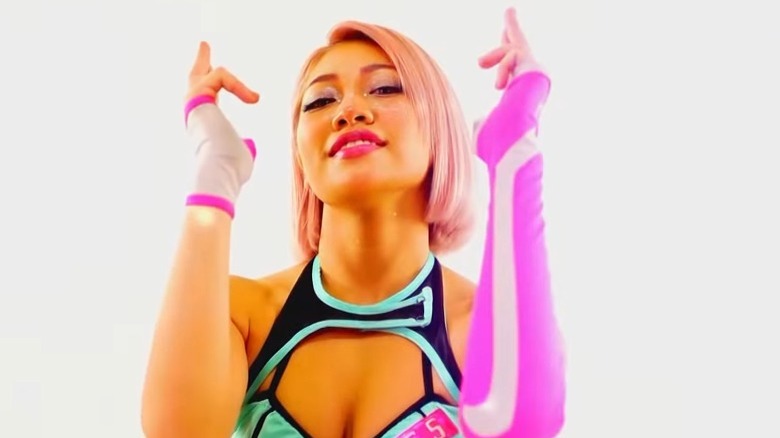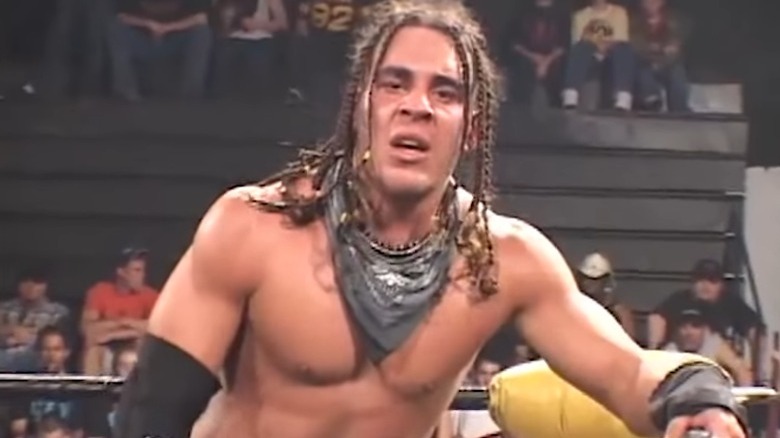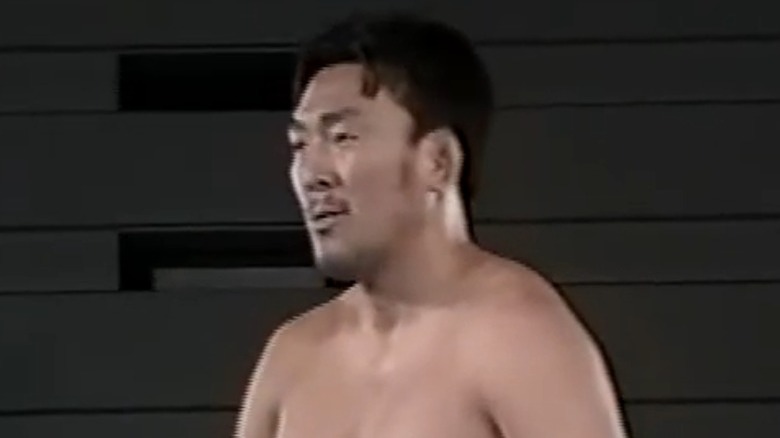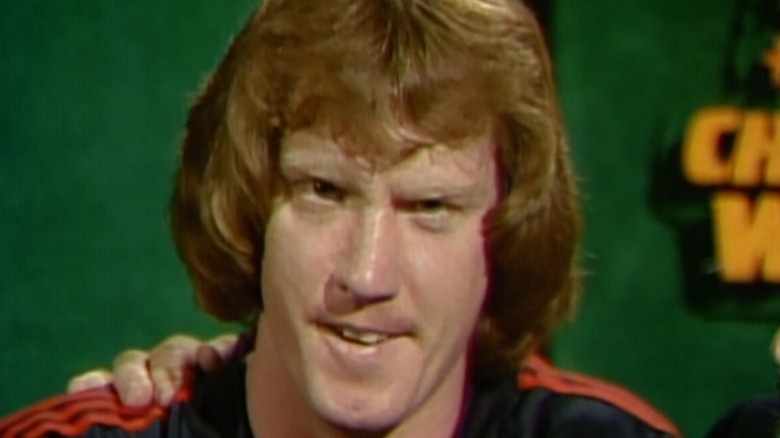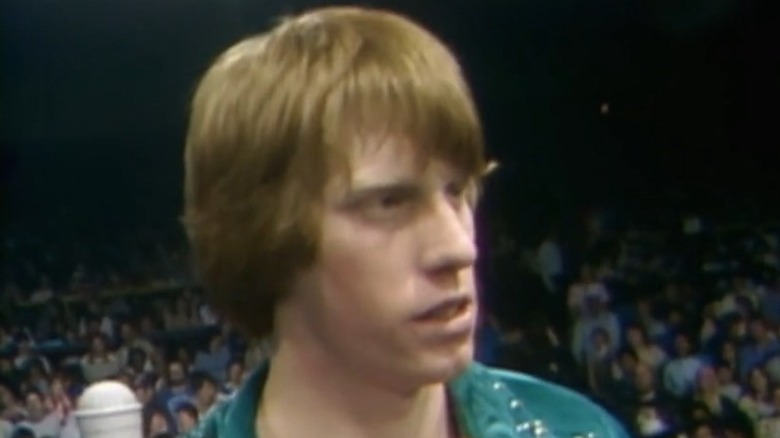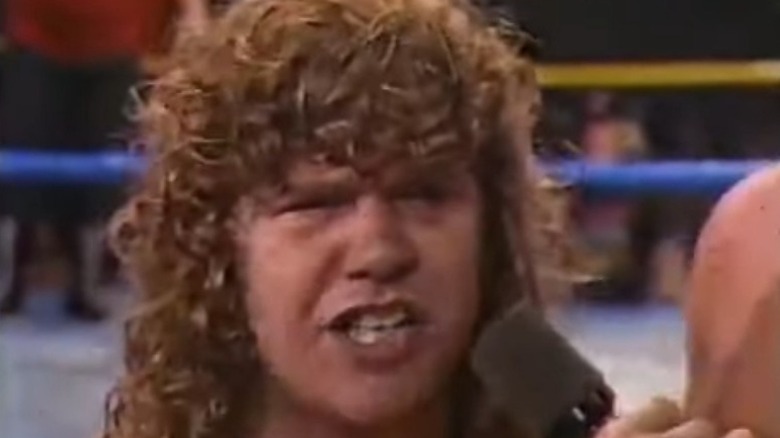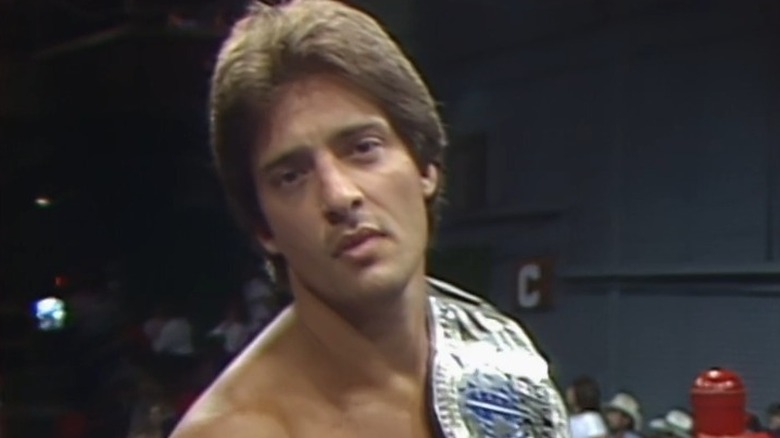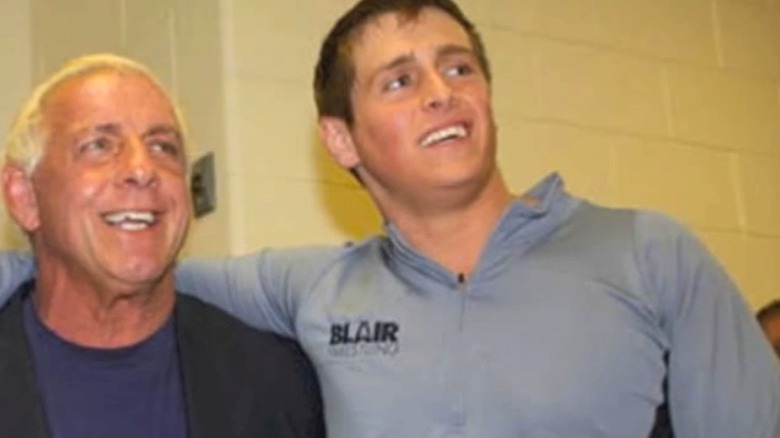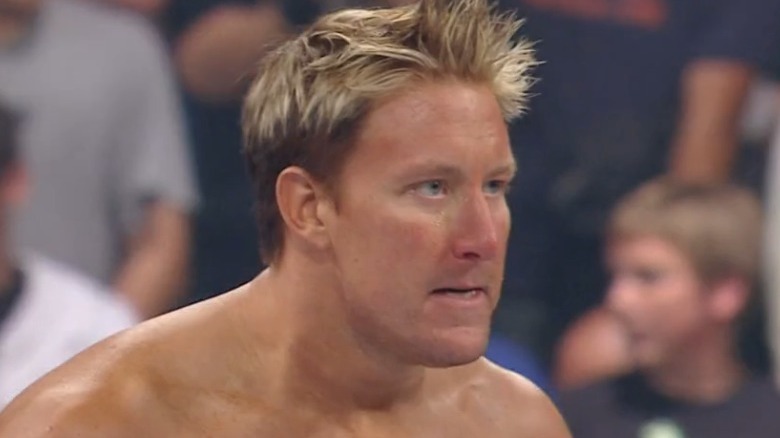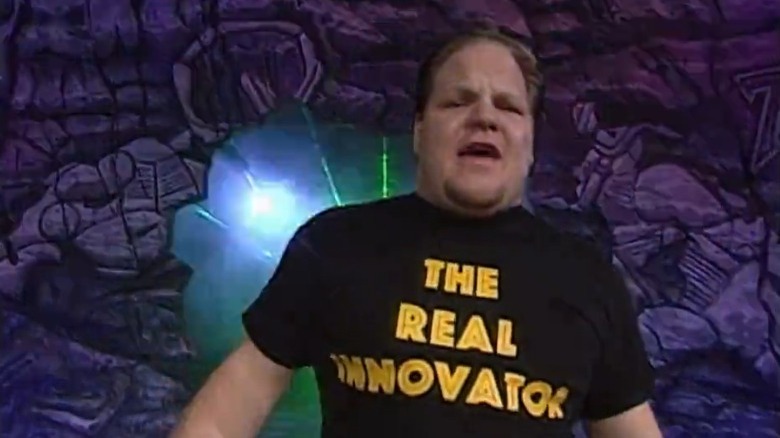Wrestlers Who Sadly Died In Their 20s
The following article contains discussion of sexual assault, suicide, and drug abuse. Please bear that in mind before you begin reading.
Wrestling has unfortunately seen more than its fair share of wrestlers who have suffered tragic deaths throughout its history. In addition to the normal bad luck with general health and accidents that can hit us all outside the ring, the pastime we love takes physical and mental tolls on the people that entertain us. We've lost far too many wrestlers far too soon, and while any of them dying before they're a ripe old age is a tragedy, the ones that hit the hardest are the youngest ones that have left us. We're going to remember some of the talents that died just as they were getting started, the ones whose careers, and lives, were cut short with the most left to give.
After applicable sections, we'll be putting in helpline phone numbers relating to the different topics addressed. Please never hesitate to reach out to these potentially life-changing resources. There's always help and there's always hope.
Art Barr
Another second-generation wrestler, Art Barr's father Sandy and brother Jesse were both also in the business, the latter known to WWF fans as Jimmy Jack Funk. Art was trained to be a wrestler by them and, upon a suggestion from his friend Roddy Piper, soon got his first taste of success when he began working as a wrestling version of the movie character Beetlejuice. The act caught on enough to capture the attention of WCW, who hired him to do a slightly modified version known as The Juicer. That run was short-lived when a faxing campaign brought into focus a prior conviction Art had received for the sexual abuse of a 19-year-old. In an attempt to rebuild his career, Barr went to Mexico and found huge success as a new character, The Love Machine.
Over the course of a few years, Barr became a major Lucha star, having runs in Mexico's two biggest promotions, CMLL and AAA. He ended up forming the tag team known as La Pareja del Terror with Eddie Guerrero. The two quickly became known as one of the best tag teams in wrestling, most notably performing at the famous AAA When Worlds Collide pay-per-view, where they lost a legendary hair versus masks tag match. Barr was poised for even greater heights, starting a run in New Japan, when he was found dead in his home of a heart attack at the age of 28. The frog splash Eddie Guerrero became so known for was actually Barr's finisher, a tribute to keep his former friend's memory alive.
If you or anyone you know has been a victim of sexual assault, help is available. Visit the Rape, Abuse & Incest National Network website or contact RAINN's National Helpline at 1-800-656-HOPE (4673).
Hana Kimura
The daughter of pro wrestler Kyoko Kimura, Hana was a second-generation star. She actually made an early appearance in wrestling at the age of 7, winning the DDT promotion's comedic Ironman Championship before losing it to her own mother. Many years later, she entered the business officially, graduating from Wrestle-1's training academy. Hana worked in Japanese promotions such as Sendai Girls and Stardom, but within just a couple years of her formally entering the wrestling business, she went on an international tour that took her to the U.K., Mexico, and even ROH in the U.S. Back home in Japan, her career with Stardom progressed to the point of her being chosen to be part of the special Stardom Offer match on the preshow of New Japan's huge Wrestle Kingdom 14 event.
Around this time, Hana also earned another opportunity, joining the cast of the reality TV show "Terrace House: Tokyo 2019-2020." A show about strangers living together, one episode saw Hana get into an argument with castmate Kai Edward Kobayashi. Once the episode hit the air, Kimura was deluged with cyberbullying, being called names, and even receiving awful racist attacks due to her mixed Japanese-Indonesian heritage. Hana died by suicide in 2020, at the age of 22. Tributes flooded in from across the wrestling world including WWE and AEW. In the fallout, Japan created harsher penalties against hateful online abuse, establishing perhaps one small piece of positivity out of a heartbreaking tragedy.
If you or anyone you know is having suicidal thoughts, please call the National Suicide Prevention Lifeline by dialing 988 or, if you're a Service member or Veteran, by calling 1-800-273-TALK (8255).
Trent Acid
A U.S. indie star of the 2000s, Trent Acid started wrestling at the age of 15. Probably best known for his work in CZW and ROH, Acid could work in the world of hardcore wrestling, but also had a talent for the fast-paced, athletic, highspot-oriented style that was starting to emerge on the scene. His tag team with Johnny Kashmere, collectively known as The Backseat Boyz, was one of the top indie tag teams for a few years, the two rising briefly to the level of ROH Tag Team Champions. The act played with the imagery of male strippers, and their ring entrances regularly featured female fans stuffing dollars down their trunks.
Unfortunately, Acid's career was plagued by troubles with drugs, as well as the law. He spent nine months in jail for assault and drug charges and a few years later in 2010, had violated his parole and agreed to rehab to avoid more jail time. For quite some time Acid had been open about his struggles with heroin addiction and how it had negatively impacted his career. Just days after finishing his rehab sentence, Trent Acid was found dead by his grandmother, having suffered a drug overdose at the age of 29. Acid went on to be posthumously inducted into the former ECW Arena's Hardcore Hall of Fame later that same year.
If you or anyone you know needs help with addiction issues, help is available. Visit the Substance Abuse and Mental Health Services Administration website or contact SAMHSA's National Helpline at 1-800-662-HELP (4357).
Plum Mariko
A submission-style wrestler with a background in Sambo, Plum Mariko was seen as a good undercard talent for the JWP promotion in Japan during the mid-'90s. Her career was filled with injuries, including breaking each of her collarbones in separate incidents, both of which required lengthy recovery times. In the time period leading up to her final match, Mariko, who had suffered multiple concussions in her career, was becoming more forgetful, as well as complaining of headaches and fatigue. In a match in August 1997, she took a standard Liger Bomb, lost consciousness, and never woke up. Despite emergency brain surgery, Mariko died the next day at 29 years of age.
Plum's death would be the first death to ever take place within a pro wrestling ring in Japan. Doctors who operated on Mariko believe the Liger Bomb was just the straw that broke the camel's back, a standard move that affected a pre-existing abscess on her brain that had resulted from a career filled with hard bumps. Multiple memorial shows and an induction into the All Japan Women's Hall of Fame have served as tributes to Mariko, and a reminder to all athletes of the worst possible consequences of working through injuries. Unfortunately, history tends to repeat itself, and Mariko's death would be no exception.
Masakazu Fukuda
In the year 2000, it was rare for New Japan to sign a wrestler to a full-time deal who was an outsider, rather than someone built from scratch through their training system. Masakazu Fukuda was the rare exception, someone who had been trained elsewhere, but so impressed New Japan brass that he was given a full-time deal. He was slated for major things in the promotion, including a role in the G-EGGS stable, a group consisting of wrestlers with real sports backgrounds, including future New Japan IWGP Champions Yuji Nagata and Manabu Nakanishi.
According to Dave Meltzer, Fukuda was also planned to do very well in that year's New Japan Young Lions tournament, penciled in to either win it or finish second. Instead, tragedy struck when Fukuda collapsed in a match with fellow Young Lion Katsuyori Shibata. He fell into a coma and died days later, only 27 years old. The cause of death was a cerebral hemorrhage. It's worth noting that Fukuda had already suffered two cerebral hemorrhages prior to this night and he required brain surgery just six months earlier. Years later, Katsuyori Shibata had his own brush with death due to brain trauma suffered in a match against Kazuchika Okada, another reminder of just how dangerous wrestling can be.
David Von Erich
For a few years in the '80s, World Class Championship Wrestling was one of the hottest territories on the planet. Chief among the reasons was an emerging group of promoter Fritz Von Erich's sons, pushed as the top stars in the company. The second oldest of them, David Von Erich, was seen as the one most likely to become a future NWA World Champion, as well as the son with the best mind for the business and therefore the most likely to run it one day. In fact, as 1984 came around, David was embroiled in a feud with the NWA champ Ric Flair, with a big match tentatively scheduled for April.
That match sadly never happened. David was found dead in a hotel room in February of that year during a tour of Japan. The cause of death has been the subject of much controversy, explored in documentaries and shoot interviews in the decades since. The officially listed cause of death was acute enteritis, but others have long suggested a drug overdose was the true culprit. No matter the reason, the age of 25 was far too young for David to leave this world, and his death was just the first of a long series of shocking tragedies to hit World Class.
Mike Von Erich
Just three years after the death of David, tragic loss hit the Von Erich family again. Mike was the fourth Von Erich brother to enter the family business, but many people that knew him have said he never really wanted to be a wrestler. The pressure to be part of the family promotion and to potentially add another star to it was immense. Unfortunately, Mike was missing much of the charisma and talent of his brothers, in addition to the passion, but he soldiered on anyway, becoming another featured act in World Class. The pressure and burden to be a star only intensified with the death of David.
On a wrestling trip to Israel, Mike suffered a shoulder injury that eventually required surgery back home. Unfortunately, there were complications to the operation and he developed a case of toxic shock syndrome that threatened his life. Mike was able to survive a fever of 107 degrees, and even eventually return to wrestling, but not without some permanent brain damage. Mike was understandably frustrated with his situation and a car accident where he suffered a further injury didn't help things. In 1987, at the age of 23, Mike Von Erich died by suicide. In terms of staggering loss, it was lightning striking twice for the Von Erich family, and it would soon strike yet again.
If you or anyone you know is having suicidal thoughts, please call the National Suicide Prevention Lifeline by dialing 988 or by calling 1-800-273-TALK (8255).
Chris Von Erich
Unlike Mike, Chris Von Erich, the youngest brother, desperately wanted to be a pro wrestler. Unluckily, Chris was also the smallest brother in addition to the youngest and had grown up with health issues including asthma. Taking the prescription drug Prednisone had resulted in his bones becoming brittle and breaking easily, but Chris pushed forward and became a wrestler anyway, trying to cope with the injuries that resulted. By the time Chris was old enough to really get into the business, the peak of World Class had long since passed, and now it was struggling for its survival.
The injuries, lack of size, state of the business, and the death of his brother Mike all weighed heavy on Chris as he tried to pursue his dream. He spiraled into depression and eventually unhealthy drug use. In 1991, at 21 years of age, Chris Von Erich died by suicide, having just reassured his brother Kevin earlier that he was alright. Soon after, older brother Kerry also died in the same manner, and, in addition to their oldest brother Jack dying at the age of 6, by 1993 Kevin Von Erich would go from having five brothers to none at all.
If you or anyone you know is having suicidal thoughts, please call the National Suicide Prevention Lifeline by dialing 988 or by calling 1-800-273-TALK (8255).
Gino Hernandez
The curse of World Class Championship Wrestling extended beyond the Von Erich family. By 1986, Gino Hernandez was one of the biggest heels in the promotion. Nicknamed The Handsome Halfbreed, Gino had the good looks and charisma to go far in wrestling. His tag team with Chris Adams was named The Dynamic Duo and was a top act, known for their gimmick of snipping off pieces of their opponent's hair, which all built to them losing a hair versus hair match to the Von Erichs. With the Von Erich feud in his rearview mirror, Hernandez soon started a major angle where he broke up his team with Adams and blinded him. This meant Gino was about to grab even more of the spotlight.
All that potential and promise came to a crashing halt when Hernandez was found dead in his condo in early 1986, his life already over at the age of 28. While the official death was ruled an accidental drug overdose, some that knew Gino insist to this day that foul play was involved. Factors that have raised suspicions include comments from Gino that his life was in danger, the amount of drugs in his system exceeded a lethal dose many times over, and his door being unlocked, something Hernandez was famously strict about. Much like the death of David Von Erich, it is a mystery that has lingered on for decades.
If you or anyone you know needs help with addiction issues, help is available. Visit the Substance Abuse and Mental Health Services Administration website or contact SAMHSA's National Helpline at 1-800-662-HELP (4357).
Reid Flair
The youngest son of the legendary Ric Flair, Reid Flair grew up around pro wrestling. He also developed some legitimate athletic skill growing up, becoming an accomplished amateur wrestler. Reid started prepping to enter the family business when he began being trained by one of his father's legendary opponents, Harley Race. Some indie appearances lead to a chance to train and wrestle for All Japan Pro Wrestling. A bright future was cut short when Reid was found dead of a drug overdose in his hometown of Charlotte, North Carolina, just 25 years old. Reid had a prior history of drug use, resulting in arrests, as well as prior overdoses.
In fact, according to Triple H on Ric Flair's ESPN "30 for 30" documentary, two failed drug tests were the only reason Reid was not signed to a WWE developmental contract. WWE star Charlotte Flair, Reid's sister, has two tattoos in honor of her late brother and has talked about how she was inspired to achieve Reid's dream of becoming a wrestling superstar. In 2015, WWE used Reid's death to build a feud between Charlotte and Paige, the latter mocking his inability to achieve that dream. The controversial segment prompted WWE to issue a statement as it was seen by many as a tasteless moment, exploiting legitimate pain for the sake of selling tickets.
If you or anyone you know needs help with addiction issues, help is available. Visit the Substance Abuse and Mental Health Services Administration website or contact SAMHSA's National Helpline at 1-800-662-HELP (4357).
Lance Cade
A student of Shawn Michaels' wrestling school, Lance Cade's career started with him working and teaming with a very famous classmate, Bryan Danielson. A WWE developmental deal soon followed and Cade spent some time working his way up to the main roster, eventually finding some traction there in a tag team with Trevor Murdoch. The two held the WWE Tag Team titles three times during their run. They eventually broke up, with Cade winning the blowoff match between the two, before moving on to a great spot being a lackey for Chris Jericho as he feuded with Cade's real-life trainer, Michaels.
Cade seemed to be on the verge of a major push. Instead, the wrestling world was shocked to wake up one day and learn that Lance had been fired from WWE. Word eventually came out about Cade's use of drugs, and his having a health issue, a seizure on an airplane, resulting in the dismissal. Cade battled his problems and worked to try to return to WWE, receiving a brief second run with the company, before dying of heart failure at the age of 29. An autopsy later ruled multiple drugs contributed to the death, yet another sad example of the huge impact substance abuse has had on pro wrestling.
If you or anyone you know needs help with addiction issues, help is available. Visit the Substance Abuse and Mental Health Services Administration website or contact SAMHSA's National Helpline at 1-800-662-HELP (4357).
Louie Spicolli
In his 27 years of life, Louie Spicolli packed a ton of travel and experiences into his wrestling career. He started at just 17 and was soon picking up jobber duty for the WWF. He traveled to U.S. indies, Japan, and eventually found more success in Mexico, particularly under the fantastic ring name Madonna's Boyfriend, among other Lucha identities. Less successful would be his brief minor push back in the WWF as the grunge scene loving Rad Radford, one of the most '90s gimmicks that ever existed. A stop in ECW got the renewed attention of the WWF, as well as WCW, during the highly competitive Monday Night Wars, and Spicolli ended up signing with the latter.
Spicolli's run in WCW would see him show off his comedy chops, both on commentary and as Scott Hall's sidekick. He was scheduled to wrestle Larry Zbyszko at SuperBrawl VIII, but, according to the Wrestling Observer (via PDRwrestling.net), died in his sleep a week before the match was to take place. Like so many of the wrestlers on this list, Spicolli's history with drugs was long and well-documented, and factored into his death. Spicolli touched so many corners of the wrestling world, but perhaps his biggest legacy is the fact that he was one of the first wrestlers to popularize the use of the Death Valley Driver, with some even calling it a Spicolli Driver for a time.
If you or anyone you know needs help with addiction issues, help is available. Visit the Substance Abuse and Mental Health Services Administration website or contact SAMHSA's National Helpline at 1-800-662-HELP (4357).


